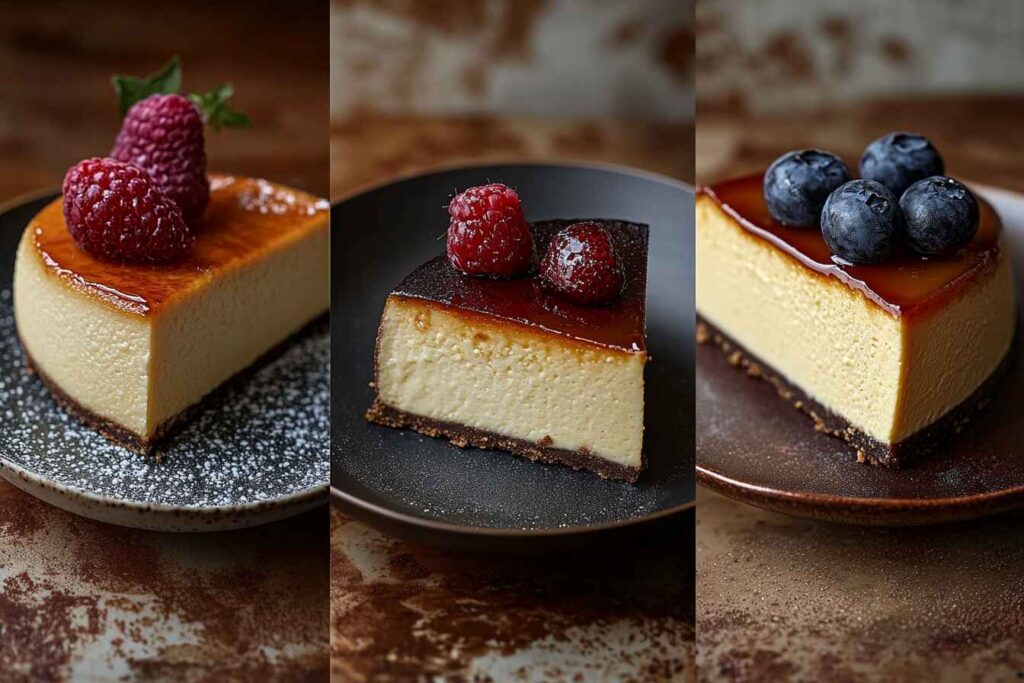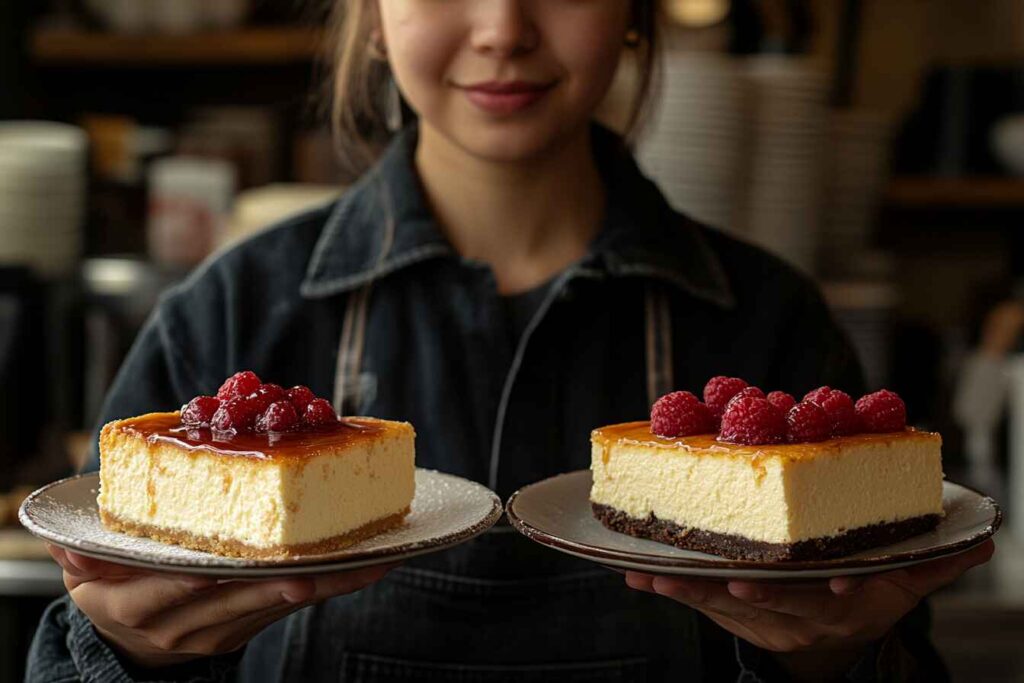Cheesecake is one of those desserts that never goes out of style. Whether you love a rich and dense New York-style slice or a light and airy no-bake version, cheesecake always hits the spot. But have you ever wondered what makes baked cheesecake different from set cheesecake? While they may look similar, these two styles are made using completely different techniques—and that’s what gives them their unique textures and flavors.
In this guide, we’ll break down the differences between baked and set cheesecake, explore their textures, ingredients, common problems, and even share some expert tips so you can make the perfect cheesecake at home!
Introduction to Cheesecake: A Dessert Loved Worldwide
Cheesecake isn’t just popular—it’s legendary. This creamy, dreamy dessert has been enjoyed for centuries, with origins tracing back to ancient Greece. Today, you’ll find variations across the globe, from the rich and dense American baked cheesecakes to the delicate and airy no-bake versions often seen in Europe and Asia.
At its core, cheesecake consists of three basic components:
- A crust – Typically made from crushed graham crackers, cookies, or biscuits.
- A creamy filling – Made from cream cheese, eggs, sugar, and other flavorings.
- A setting method – Either baked in an oven or chilled to set.
Now, let’s dive deeper into the world of baked cheesecakes.

What is a Baked Cheesecake?
Baked cheesecake is the classic version you’re probably familiar with. It has a rich, dense, and creamy texture, thanks to the combination of eggs and cream cheese that are baked together. The heat transforms the ingredients, creating a smooth and velvety texture.
Definition and Origins of Baked Cheesecake
The origins of baked cheesecake can be traced back to ancient Greece, where it was served to athletes during the first Olympic Games. However, the modern version we know today, particularly the New York-style cheesecake, became popular in the early 1900s.
How is Baked Cheesecake Made?
Baking a cheesecake requires patience, precision, and the right technique. Here’s a step-by-step process of how it’s made:
Ingredients for a Classic Baked Cheesecake
Ingredient Quantity Cream cheese 500g (18oz) Granulated sugar 1 cup Eggs 3 large Sour cream 1 cup Vanilla extract 1 tsp Graham cracker crust 1 pre-made or homemade
Step-by-Step Process:
- Prepare the crust: Mix crushed graham crackers with melted butter and press it into a springform pan.
- Make the filling: Beat cream cheese, sugar, and vanilla extract until smooth.
- Add eggs one at a time: Mix gently to avoid overbeating, which can cause cracks.
- Bake in a water bath: Place the cheesecake pan in a larger pan filled with hot water and bake at 325°F (163°C) for about an hour.
- Cool gradually: Let it sit in the oven with the door slightly open before transferring it to the fridge.
Texture and Flavor Profile of Baked Cheesecake
Baked cheesecake has a dense yet creamy texture with a slightly firm outer layer. The flavors are richer because the eggs help create a custard-like consistency.
Key Features:
- Rich and dense texture
- Creamy and smooth mouthfeel
- Deeper flavors due to caramelization
Popular Variations of Baked Cheesecake
Depending on the region and ingredients used, baked cheesecakes come in many variations. Some popular types include:
- New York-Style Cheesecake – Extra creamy, often made with heavy cream and baked at a lower temperature.
- Japanese Cheesecake – Light and fluffy, thanks to whipped egg whites.
- Basque Burnt Cheesecake – Caramelized on top with a soft, gooey center.
Common Problems with Baked Cheesecake and How to Fix Them
While baked cheesecakes are delicious, they can be tricky to master. Here are some common problems and solutions:
Why Does My Baked Cheesecake Crack?
Cracks are one of the most common issues, and they happen because of rapid temperature changes or overmixing the batter.
How to Fix:
- Use a water bath to create gentle, even heat.
- Don’t overbeat the batter; mix just until combined.
- Cool the cheesecake gradually in the oven before refrigerating.
How to Prevent Overbaking or Undercooking?
Overbaking leads to a dry texture, while underbaking makes the center too runny.
How to Fix:
- Bake at low heat (325°F) for even cooking.
- Use the jiggle test: The center should wobble slightly but not be liquid.
Water Bath vs. No Water Bath: Which is Best?
Using a water bath is one of the best ways to ensure a smooth texture. However, if you prefer a slightly firmer and drier cheesecake, you can skip it.
Pros of a Water Bath:
- Prevents cracks
- Creates an ultra-creamy texture
Cons of a Water Bath:
- Can be tricky to set up
- Risk of water seeping into the crust
That wraps up our first part! Stay tuned for the next section, where we’ll dive into set (no-bake) cheesecake and how it differs from its baked counterpart.
What is a Set (No-Bake) Cheesecake?
Unlike baked cheesecake, set cheesecake (also known as no-bake cheesecake) is prepared without using an oven. Instead, it relies on refrigeration to firm up. This version is perfect for those who prefer a lighter, silkier texture with a refreshing taste. Plus, it’s an excellent choice for warm weather when turning on the oven sounds like a nightmare!
Definition and Origins of Set Cheesecake
Set cheesecake became popular in the mid-20th century as refrigeration became more common in households. With its easy preparation and deliciously smooth texture, it quickly gained popularity worldwide. This style is often associated with classic European and Asian cheesecakes that focus on lighter ingredients.
How is Set Cheesecake Made?
Set cheesecake is made by mixing cream cheese with whipped cream, sugar, and flavorings, then allowing it to firm up in the fridge. Since there are no eggs involved, the texture remains soft and airy rather than dense and custard-like.
Ingredients for a Classic No-Bake Cheesecake
Ingredient Quantity Cream cheese 500g (18oz) Heavy whipping cream 1 cup Powdered sugar 3/4 cup Vanilla extract 1 tsp Gelatin or agar-agar (optional) 1 tbsp Graham cracker crust 1 pre-made or homemade
Step-by-Step Process:
- Prepare the crust: Mix crushed graham crackers with melted butter, then press firmly into a pan.
- Beat the cream cheese: Whip cream cheese with powdered sugar and vanilla extract until smooth.
- Whip the cream separately: Beat heavy cream until soft peaks form, then fold it into the cream cheese mixture.
- Add a stabilizer (optional): If using gelatin, dissolve it in warm water and mix it in to help the cheesecake hold its shape.
- Chill the cheesecake: Pour the mixture over the crust and refrigerate for at least 4-6 hours, preferably overnight.
Texture and Flavor Profile of Set Cheesecake
Since set cheesecake doesn’t undergo any heat treatment, it has a much lighter and silkier texture than baked cheesecake. It’s almost like a cross between cheesecake and mousse!
Key Features:
- Light and airy texture
- Refreshing and cool, perfect for summer
- More delicate structure, can melt faster
Popular Variations of Set Cheesecake
No-bake cheesecakes come in many flavors and styles, often incorporating fresh fruit, chocolate, or even coffee. Some popular variations include:
- Lemon No-Bake Cheesecake – A refreshing citrusy version with a tangy taste.
- Strawberry Cheesecake – Topped with fresh strawberries and a glaze.
- Oreo Cheesecake – Crushed Oreos mixed into the filling for a cookies-and-cream delight.
- Matcha Cheesecake – A Japanese-inspired take with earthy green tea flavors.
Key Differences Between Baked and Set Cheesecake
Now that we’ve explored both types, let’s compare them side by side.
Baked Cheesecake vs. Set Cheesecake – A Quick Comparison
Feature Baked Cheesecake Set (No-Bake) Cheesecake Texture Dense, rich, custard-like Light, airy, mousse-like Main Ingredients Cream cheese, eggs, sugar Cream cheese, whipped cream, sugar Cooking Method Baked in an oven Chilled in the fridge Best Served At room temperature Chilled Difficulty Level Moderate – Requires careful baking Easy – No baking required
Common Problems with Set Cheesecake and How to Fix Them
While no-bake cheesecake is easier to make, it can still come with a few challenges. Here’s how to troubleshoot the most common issues.
Why is My No-Bake Cheesecake Runny?
If your set cheesecake doesn’t firm up, it could be due to:
- Not chilling it long enough
- Not using enough stabilizers like gelatin
- Overmixing the whipped cream, causing it to lose structure
How to Fix:
- Let it chill for at least 6 hours or overnight.
- Use gelatin or agar-agar for extra firmness.
- Gently fold in whipped cream instead of mixing aggressively.
How to Achieve the Perfect Firmness?
Set cheesecake needs time to firm up properly. If it’s too soft, here’s what you can do:
- Increase the amount of whipped cream for more stability.
- Ensure all ingredients are cold before mixing.
- Use a higher proportion of cream cheese to avoid a soupy consistency.
Best Tips for Chilling and Setting Properly
Chilling is crucial for no-bake cheesecake. Here are some golden rules:
- Refrigerate for at least 6 hours (overnight is best).
- Cover it to prevent fridge odors from affecting the taste.
- Use a springform pan lined with parchment paper for easy removal.
Which Cheesecake is Best for You?
So, which cheesecake should you make? It depends on your preferences and occasion!
Best Occasions for Each Type
- Baked Cheesecake – Perfect for special occasions, holidays, and people who love a rich dessert.
- Set Cheesecake – Ideal for summer, quick desserts, and beginners in baking.
Tips for Making the Perfect Cheesecake (Baked and Set)
Now that we’ve covered the differences between baked and set cheesecake, it’s time to dive into some expert tips to ensure your cheesecake turns out perfect every time! Whether you’re making a dense, creamy baked cheesecake or a light, airy no-bake version, these pro tips will help you avoid common mistakes and achieve the best results.
Expert Tips for Baked Cheesecake Success
Baked cheesecakes require precision and patience. Follow these tips to make sure yours comes out smooth, creamy, and crack-free.
- Use room temperature ingredients: Cold cream cheese can create lumps in the batter. Let all ingredients sit at room temperature for about 30 minutes before mixing.
- Avoid overmixing: Overbeating incorporates too much air, leading to cracks. Mix just until the ingredients are combined.
- Always use a water bath: A water bath (bain-marie) creates gentle, even heat, preventing the cheesecake from drying out or cracking.
- Don’t open the oven door too soon: Sudden temperature changes can cause cracks. Leave the cheesecake in the oven with the door slightly open after baking to cool gradually.
- Chill overnight: Refrigerate for at least 6 hours (preferably overnight) for the best texture and flavor.
Expert Tips for Set (No-Bake) Cheesecake Success
Set cheesecakes are easier to make, but they still need some finesse to get the perfect structure and taste. Here’s how:
- Use full-fat cream cheese: Low-fat versions can make the cheesecake too soft and watery.
- Whip the cream properly: Beating the heavy cream to soft peaks ensures a stable yet light texture.
- Don’t skip the chilling time: The cheesecake needs at least 6 hours to firm up, but overnight is best.
- Use gelatin or agar-agar (if needed): If you want a firmer set, dissolve 1 tbsp of gelatin in warm water and mix it into the filling.
- Line the pan with parchment paper: This makes it easier to remove the cheesecake without sticking.
Final Comparison: Which Cheesecake Should You Choose?
Still unsure which cheesecake to make? Let’s break it down even further.
Quick Decision Guide: Baked vs. Set Cheesecake
Factor Baked Cheesecake Set (No-Bake) Cheesecake Texture Dense, creamy, rich Light, airy, mousse-like Cooking Method Baked in an oven Chilled in the fridge Time Required Longer (includes baking + cooling) Faster (no baking required) Best for Warm Weather? No (requires oven) Yes (no heat needed) Best for Special Occasions? Yes (more traditional and impressive) Yes (easy and refreshing) Skill Level Intermediate to advanced Beginner-friendly
Choose baked cheesecake if: You love a rich, custard-like texture and don’t mind the extra baking time.
Choose set cheesecake if: You prefer a light, creamy texture and want a quick, no-fuss dessert.

FAQs About Cheesecake
Can I freeze cheesecake?
Yes! Both baked and set cheesecakes freeze well. Just wrap them tightly in plastic wrap and store them for up to 2 months.
How long does cheesecake last in the fridge?
Baked cheesecake lasts 5-7 days, while set cheesecake is best eaten within 3-4 days.
Can I make a cheesecake without a crust?
Absolutely! Many recipes allow you to make crustless cheesecakes by simply pouring the filling into a greased pan or ramekins.
Why is my cheesecake too soft?
This usually happens if it wasn’t chilled long enough or if too much liquid was added. Let it sit in the fridge longer or use a stabilizer like gelatin.
Conclusion: Baked vs. Set Cheesecake – Which One is Right for You?
Cheesecake is one of the most versatile and beloved desserts, and whether you choose a baked or set (no-bake) version depends entirely on your preferences.
If you love a rich, dense, and indulgent dessert, baked cheesecake is your best bet. It requires a little more effort, but the result is a decadent, melt-in-your-mouth treat.
On the other hand, if you want something light, refreshing, and quick to prepare, set cheesecake is the way to go. With no baking required, it’s an easy and beginner-friendly option for any occasion.
Whichever you choose, both versions of cheesecake offer something deliciously special. Why not try making both and see which one becomes your favorite?
Now, go grab your ingredients and whip up the perfect cheesecake!

